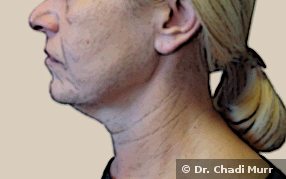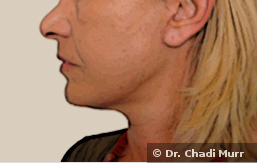Welcome to Dr. Chadi Murr
Facelift or Rhytidectomy – Plastic Surgery
Facelifiting, or Rhytidectomy, is the surgical removal of excess facial skin to reduce wrinkles and visible signs of aging.
Read MoreGravity, excessive sun exposure, smoking and stress will eventually leave their mark on the face and neck. Deep creases on both sides of the mouth, a saggy jaw line and folded neck skin are inevitable consequences that can’t be corrected with creams or simple fillings.
In this case, a facelift is the perfect solution to remove excess facial skin and tighten the underlying tissues, thus giving the face a more youthful and appealing contour.
Am I a good candidate?
Rhytidectomy is considered a great option for men and women above 40 years of age, who have a sagging face skin but which is still elastic to some extent.
Read MoreThis plastic surgery reduces the signs of aging but doesn’t stop the aging process. Moreover, the purpose of a facelift is to reduce skin sagginess and not to reshape the face. Good candidates are non-smokers and healthy individuals who do not have medical conditions that can impair healing or increase complication risks. I will evaluate your general health status and any pre-existing conditions or risk factors, discuss your options and recommend a course of treatment accordingly.

How is it done?
The face lifting surgery takes three to five hours and is done either under intravenous sedation or general anesthesia. The decision is made according to the patient’s condition. Read More
Incisions are made on both sides of the face, starting down from the hairline, upward around the earlobe and ending in the hairline behind the ear. It is done in a way to hide the scars along the face’s natural creases, and the patient can easily conceal them with hair or makeup..
The underlying muscle and connective tissue are lifted and tightened with special sutures to correct sagginess. Once done, the excess skin is trimmed and the remaining skin draped over the muscles without stretching it too much to avoid unnatural results. If needed, I will remove excess fat using liposuction. Finally, the incision is closed with sutures. If the patient’s face looks thin and unhealthy, the face can also be restructured by injecting autologous fat – which is the patient’s own fat. According to the patient’s condition, the facelift can be paired with other facial cosmetic procedures such as a brow lift to accomplish a harmoniously youthful facial appearance.

How long is the recovery?
Once the surgery over, the incisions are covered with dressings and the head wrapped with bandages to reduce swelling.
Read More
Following the instructions is key to the success of your surgery. It is important that the surgical incisions are not subjected to excessive force, abrasion or motion during the healing process. Normal but light activity can be resumed within one week or two, and exercise can be slowly brought back into your lifestyle four weeks after surgery. Disclaimer: The info presented on this page is indicative and for generic use only. Each patient’s case is unique and will be studied by Dr. Chadi Murr for full assessment. Drainage tubes are removed the following day and the stitches one week later.
Swelling and bruising are natural signs of the healing process. The patients might experience stiffness in the face’s muscle and unevenness in the face’s shape due to swelling. Most of these signs resolve within three to six weeks, and scars become less visible and less itchy with time.
